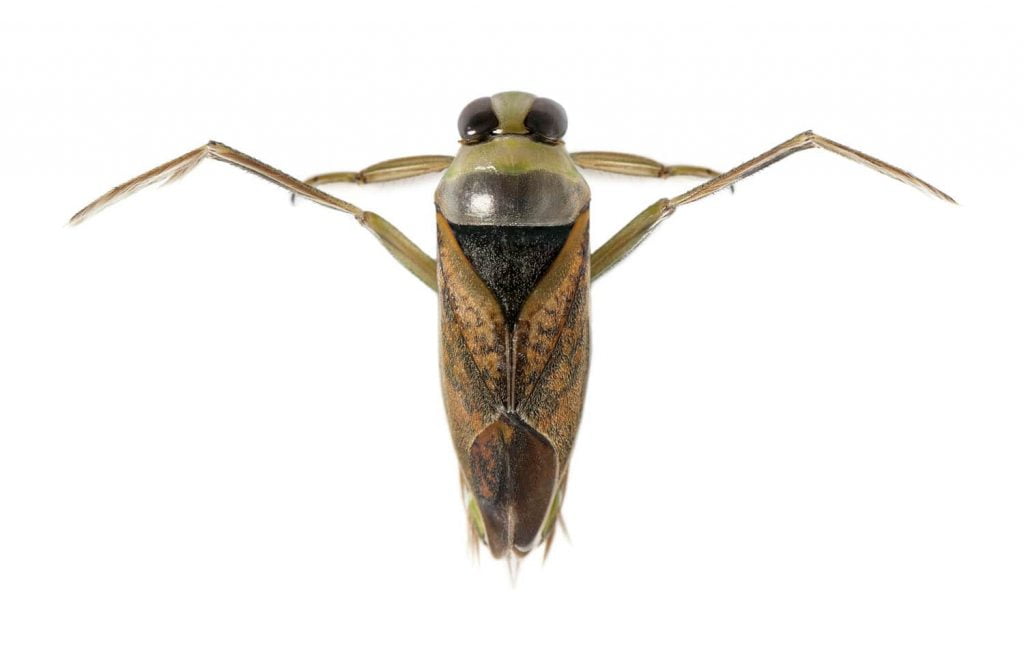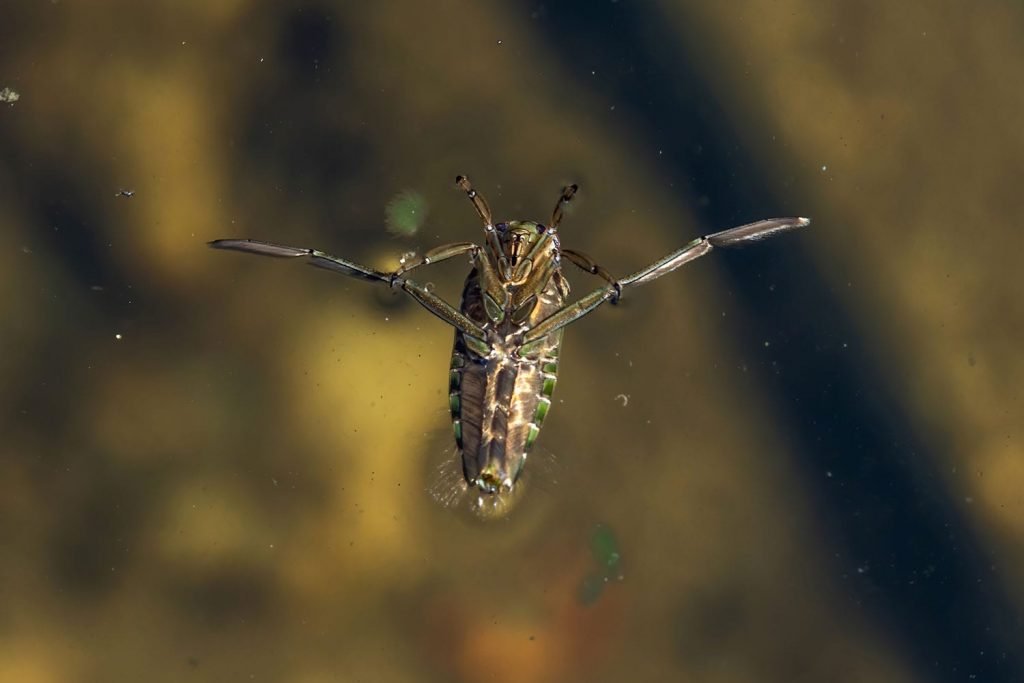Water bugs have, time and again, proved to be a menace in pool cleaning and maintenance for most pool owners. They start small, and before you know it, they are running your swimming pool. While some are beneficial in one way or another, some of them bite and cause some real pain.
What’s more, the water bugs can make your swimming pool look and feel nasty. So, it’s understandable if you’re fed up with their presence, and you want to get rid of them.
This post is here to take you through the topic and, in the end, layout a straightforward process of getting rid of the water bugs in your pool and how to prevent them from coming back.
What Are Types of Water Bugs You Can Find in Your Pool
Water bugs that can invade your swimming pool are of two main types, water boatmen and backswimmers.
1. Water Boatmen

Water boatmen are oval-shaped bugs with brown-greenish color and some spots on the wings. They are distinctive because of their scary look.
They usually are half an inch long and feature longer rear-most legs. They are also fringed with hair to help them stay afloat and paddle on the water. That’s why they are called the ‘Water Boatmen.’
Despite their look, water boatmen bugs are harmless. They might be beneficial to your backyard as they eat mosquito larvae before becoming the biting mosquitos.
Are water boatmen dangerous? No! These bugs don’t bite, and neither are they poisonous. They are mainly docile. They might look frightening, but as far as insects go, water boatmen are won’t harm anyone.
They are primarily near your pool because there might be food. If you start to see the water boatmen around, there is algae growth in your swimming pool.
How Do You Get Rid of Water Boatmen?
Since they are attracted mainly by algae (their food) and egg-laying habitat, you can treat the water with an algaecide to kill it and starve them. They will have no other option but to leave. You might want to skim them out before treating the water.
2. Backswimmers

Backswimmers are the opposite of water boatmen. These bugs bite and the bites can be painful; they have similarities, though. They do look alike at first glance, but they have a light to medium brown color. What’s more, their back legs are longer, and fringes for easy skimming across the water, and they are half-inch long.
One distinctive feature that differentiates them from the water boatmen is the upside-down swimming design which gives them the name ‘backswimmers.’ It’s easy to mistake them with water boatmen unless you look at how they swim.
They belong to the Notonectidae family in the Hemiptera order of true bugs. And unlike the water boatmen, they eat other bugs, including the water boatmen themselves. Their main attraction to your pool would be their food, the water boatmen. They don’t eat algae, but they do lay in them.
Are backswimmers dangerous? Yes! They do bite, and their bites can be nasty and painful, like bee stings. They aren’t poisonous, though.
How Do You Get Rid of Backswimmers?
The best way to get rid of the backswimmers is to get rid of the water boatmen as they are their source of attraction to your swimming pool.
What is the Best to Get Rid of Water Bugs in Your Pool
To get rid of the water bugs in your swimming pool, you want to get rid of their food, with water boatmen’s being algae and the backswimmers’ being the water boatmen. It all comes down to cleaning the swimming pool and ensuring algae never grows.
Here are the steps you can take to get rid of water bugs in your pool.
1. Skim the Water Bugs Out
Before taking any remedies to the bug problem, you want to get the bugs out of the water by skimming them with a pool skimmer. Of course, killing them isn’t considering you might be left with a lot of mess to deal with, and it might be too harsh for them. You might even consider relocating them to an area with mosquitos to eat the mosquito larvae.
2. Vacuum Your Pool
With most of the water bugs out, manually vacuum the pool to remove as much sediment and debris as you can. Vacuum to waste to prevent the dirt that might be containing algae blooms from returning to your pool. Avoid using an automatic cleaner as it might disperse the algae.
3. Brush Your Pool
Use algae brush compatible with your swimming pool to scrub the surfaces thoroughly, including the steps and the ladders if yours has them. You want to loosen the clinging algae from all the surfaces.
4. Test the Pool Water
Use test strips, liquid test kits, or digital tests to ensure the alkalinity and pH are appropriately balanced. You want to make sure the levels should be between 7.4 – 7.6 and 100 – 150ppm, respectively. If they aren’t, adjust them accordingly. That allows the chlorine shock to work appropriately and effectively.
5. Shock the Pool
Now, since we’re talking about controlling the algae, food for these tiny water bugs, you will need an extra dose of your regular pool shock dosage. With the standard dose of a pool shock being 1 pound per 10,000 gallons of water, here you want to double the dose, 2lbs per 10,000 gallons. If the water is more green or yellow, consider tripling the dose.
Pro tip: Add the pool shock at night or after sunset. The sun does reduce the chlorine level by oxidizing it. That reduces the chlorine levels, thus reducing its effectiveness.
6. Circulate the Water
After adding the pool shock, you will need to distribute it well to all the corners allowing it to work as intended and dissipate to and allow you to enjoy your swimming pool afterward. Run the pool pump for 8-12 hours, if you can overnight. If you triple the pool shock, circulate the pool for 24 hours. Before dipping yourself in the water, test the chlorine levels to ensure they have returned to normal.
7. Test and Balance the Pool Chemistry
Once you confirm the chlorine levels are back to normal, 1 – 3ppm, test the pool pH and alkalinity to ensure they are balanced; If they aren’t, use the right increaser or decreaser agent to balance them.
How Do You Keep Them From Returning?
It’s pretty understandable if you don’t want to deal with these tiny insects. So, you want to find a way to discourage them from visiting your pool area. What can you do?
1. Maintain the Proper Chemistry Levels
The number one step of keeping the water bugs is ensuring your pool chemistry levels stay normal to discourage algae growth, eliminating their source of food. Ensure the water chemistry levels stays are these levels:
- 7.4 to 7.6 pH
- 1 – 3ppm Chlorine
- 80 – 140ppm Total alkalinity
2. Skim Your Pool Regular
Get a pool skimmer net and try skimming debris off the pool surface at least once a day. This can help remove any floating algae spores and prevent them from setting at the bottom and growing algae.
3. Use Algaecide
If you don’t remember the last time you shock your swimming pool, consider using algaecide to kill any algae spores and blooms that might be lingering in your pool. The whole idea is to keep your swimming pool as clean and free of algae as you can.
4. Cover the Swimming Pool
You can also consider covering your swimming pool when you’re not using it. It’ll help keep things out, including water bugs and algae spores, from sneaking into the pool water.
5. Turn Off Your Pool Lights
Most bugs, including the water bugs, are attracted to light, and leaving your pool lights on won’t help. Try shutting them off at night. You can install motion sensor lights that go on when someone walks around the swimming pool.
Related Questions
What kills water bugs instantly?
If you decide to kill the water bugs instantly, you can use baking soda, regular dishwasher detergent, and alcohol. Pour any of these products on the water bugs or their nests, and they will do the rest. Baking soda is a safe and popular bug controller because of its moisture-absorbing nature. It will dehydrate the bugs, killing them.
Is it safe to swim in a pool with water bugs?
I don’t think so. Unless you’re okay with getting into a pool with algae nesting water bugs eggs, then you might want to stay away from the swimming pool until you get rid of them and clean everything out. Another thing, if there are backswimmers in your water, their bites can be painful, especially if you’re bitten by more than one bug.


Leave a Comment